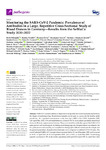2023-04-02Zeitschriftenartikel
Monitoring the SARS-CoV-2 Pandemic: Prevalence of Antibodies in a Large, Repetitive Cross-Sectional Study of Blood Donors in Germany—Results from the SeBluCo Study 2020–2022
Offergeld, Ruth
Preußel, Karina
Zeiler, Thomas
Aurich, Konstanze
Baumann-Baretti, Barbara I.
Ciesek, Sandra
Corman, Victor M.
Dienst, Viktoria
Drosten, Christian
Görg, Siegfried
Greinacher, Andreas
Grossegesse, Marica
Haller, Sebastian
Heuft, Hans-Gert
Hofmann, Natalie
Horn, Peter A.
Houareau, Claudia
Gülec, Ilay
Jiménez Klingberg, Carlos Luis
Juhl, David
Lindemann, Monika
Martin, Silke
Neuhauser, Hannelore K.
Nitsche, Andreas
Ohme, Julia
Peine, Sven
Sachs, Ulrich J.
Schaade, Lars
Schäfer, Richard
Scheiblauer, Heinrich
Schlaud, Martin
Schmidt, Michael
Umhau, Markus
Vollmer, Tanja
Wagner, Franz F.
Wieler, Lothar H.
Wilking, Hendrik
Ziemann, Malte
Zimmermann, Marlow
an der Heiden, Matthias
SARS-CoV-2 serosurveillance is important to adapt infection control measures and estimate the degree of underreporting. Blood donor samples can be used as a proxy for the healthy adult population. In a repeated cross-sectional study from April 2020 to April 2021, September 2021, and April/May 2022, 13 blood establishments collected 134,510 anonymised specimens from blood donors in 28 study regions across Germany. These were tested for antibodies against the SARS-CoV-2 spike protein and nucleocapsid, including neutralising capacity. Seroprevalence was adjusted for test performance and sampling and weighted for demographic differences between the sample and the general population. Seroprevalence estimates were compared to notified COVID-19 cases. The overall adjusted SARS-CoV-2 seroprevalence remained below 2% until December 2020 and increased to 18.1% in April 2021, 89.4% in September 2021, and to 100% in April/May 2022. Neutralising capacity was found in 74% of all positive specimens until April 2021 and in 98% in April/May 2022. Our serosurveillance allowed for repeated estimations of underreporting from the early stage of the pandemic onwards. Underreporting ranged between factors 5.1 and 1.1 in the first two waves of the pandemic and remained well below 2 afterwards, indicating an adequate test strategy and notification system in Germany.

